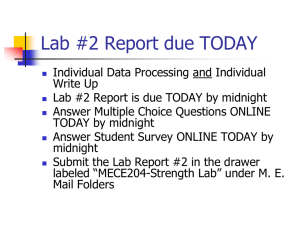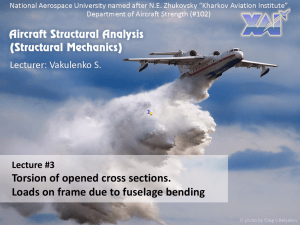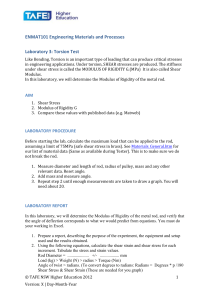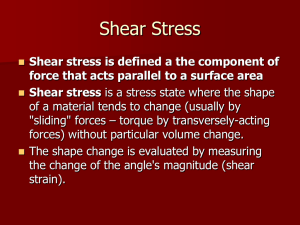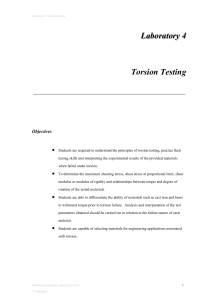Torsion Lab. Report
advertisement
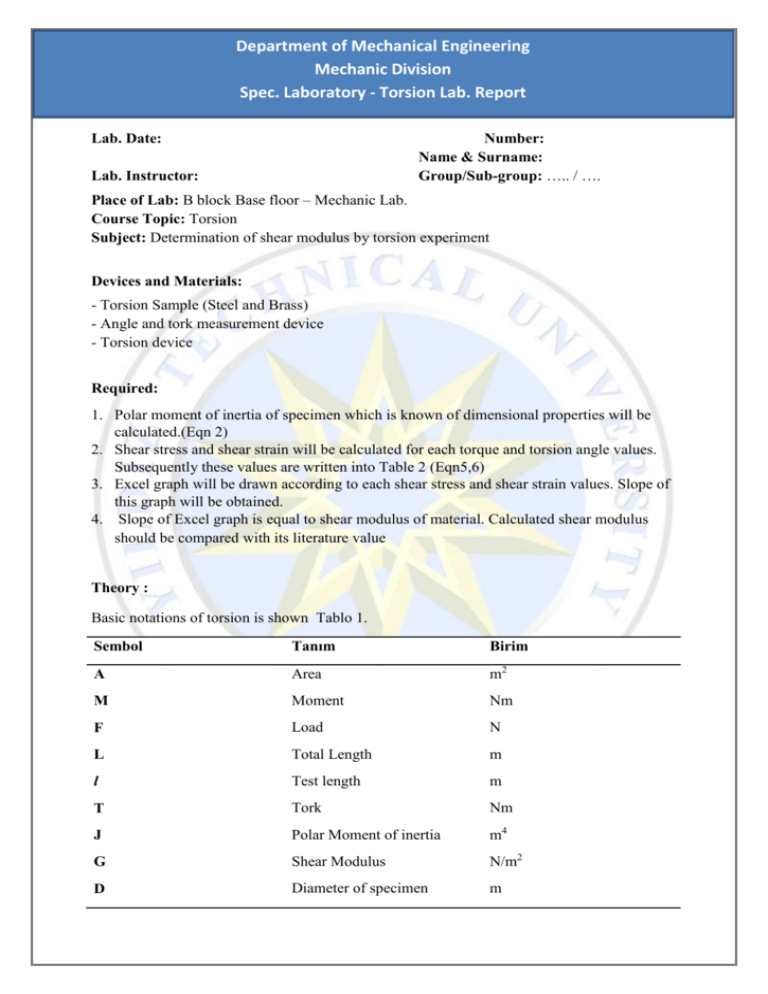
Department of Mechanical Engineering Mechanic Division Spec. Laboratory - Torsion Lab. Report Lab. Date: Number: Name & Surname: Group/Sub-group: ….. / …. Lab. Instructor: Place of Lab: B block Base floor – Mechanic Lab. Course Topic: Torsion Subject: Determination of shear modulus by torsion experiment Devices and Materials: - Torsion Sample (Steel and Brass) - Angle and tork measurement device - Torsion device Required: 1. Polar moment of inertia of specimen which is known of dimensional properties will be calculated.(Eqn 2) 2. Shear stress and shear strain will be calculated for each torque and torsion angle values. Subsequently these values are written into Table 2 (Eqn5,6) 3. Excel graph will be drawn according to each shear stress and shear strain values. Slope of this graph will be obtained. 4. Slope of Excel graph is equal to shear modulus of material. Calculated shear modulus should be compared with its literature value Theory : Basic notations of torsion is shown Tablo 1. Sembol Tanım Birim A Area m2 M Moment Nm F Load N L Total Length m l Test length m T Tork Nm J Polar Moment of inertia m4 G Shear Modulus N/m2 D Diameter of specimen m r Radius of specimen m τ Shear stress N/m2 γ Shear strain --- θ Angle of twist Radyan Shear Modulus It is the ratio of shear stress and shear strain of the material. G= Shear Stress τ = Shear Strain γ (1) This formula only work when the material is stressed in its elastic region. Polar Moment of Inertia A higher polar moment of inertia shows that the beam or specimen can resist a higher torsion or twisting force. The diameter of the beam determines polar moment of inertia. J= D4 32 (2) Torque (Torsion Moment) Figure 1 Torsion In order to calculate angle of twist; = Tl GJ (4) Shear Stress The theoretical shear stress for a solid circular bar is τ= TD 2J (5) Shear Strain γ= τ r G l (6) Rearrange shear modulus ; G (TD) / 2 J (r ) / l (7) ELASTİK-PLASTİK DEFORMASYON This type of deformation is reversible. Once the forces are no longer applied, the object returns to its original shape. Normal metals, ceramics and most crystals show linear elasticity and a smaller elastic range. This type of deformation is irreversible. However, an object in the plastic deformation range will first have undergone elastic deformation, which is reversible, so the object will return part way to its original shape. Figure 2 Stress-Strain curve Generally material has one yield point under normal circumstances however lower carbon steel as specified mild steel has two yield point as shown figure 2. 1. Discussion: 1) Locate torsion specimen . 2) Firstly angle meter mount on torsion specimen then plastic cap close slowly. 3) During experiments, all torques and corresponding angles are noted. Figure 3 Torsion Test Devices 2. Conclusion: Table 2 is filled according to values that obtained after the experiments. Shear stress and shear strain values which exist in table are drawn graph by excel then were easily obtained the slope of this graph. Slope of excel graph is equal to shear modulus of material. Finally calculated shear modulus should be compared with its literature value Table 2 Angle of Twist (Radyan) Torque (N.m) Shear Stress Shear strain 0 0 0 0 0.005 0.01 0.015 0.02 0.025 0.03
